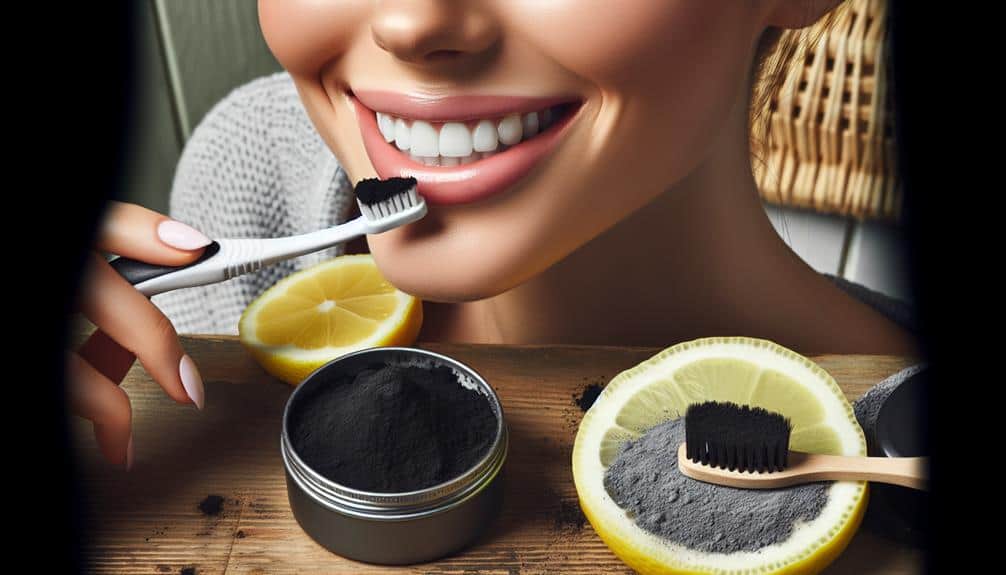Achieve a brighter smile with top DIY baking soda teeth whitening methods. This natural ingredient has been used for decades in oral hygiene and is effective at removing surface stains, thanks to its mild abrasive properties that scrub away plaque. By creating an alkaline environment in your mouth, baking soda promotes better oral hygiene. Remember to limit the frequency of use to prevent enamel wear and make sure you brush gently in small, circular motions for 2-3 minutes. Rinse your mouth thoroughly afterward and follow up with regular toothpaste. These steps will help you maintain a brighter smile naturally.
Key Points
- Dampen toothbrush and dip in baking soda for gentle application.
- Brush in circular motions to avoid enamel damage.
- Limit whitening time to 2-3 minutes to prevent erosion.
- Rinse thoroughly after brushing to remove residue.
- Follow up with regular toothpaste to balance pH levels.
Benefits of Baking Soda Teeth Whitening
When used correctly, baking soda teeth whitening can effectively remove surface stains and brighten your smile. Baking soda is a natural ingredient that has been used for decades in oral hygiene. Its mild abrasive properties help scrub away plaque and stains from the surface of your teeth without causing damage to the enamel when used in moderation. By creating a paste with baking soda and water, you can gently polish your teeth, revealing a whiter appearance.
In addition to its whitening capabilities, baking soda can also contribute to better oral hygiene. It creates an alkaline environment in your mouth, which can help neutralize acids produced by bacteria, reducing the risk of tooth decay and gum disease. Baking soda can also freshen your breath by eliminating odor-causing bacteria. Incorporating baking soda into your oral care routine can be a cost-effective and natural way to maintain a bright and healthy smile.
Precautions for Baking Soda Whitening
To guarantee safe and effective results when using baking soda for teeth whitening, it's important to be mindful of certain precautions. When it comes to precautionary measures for baking soda whitening, here are some key points to keep in mind:
- Limit Frequency: Overusing baking soda can wear down enamel, so it's best to use it sparingly.
- Check for Abrasiveness: Make sure the baking soda is finely ground to avoid damaging your enamel.
- Monitor Tooth Sensitivity: If you experience increased tooth sensitivity, discontinue use and consult your dentist.
- Avoid Harsh Scrubbing: Gentle motions are sufficient for effective whitening without harming your teeth.
- Rinse Thoroughly: After whitening, make sure to rinse your mouth thoroughly to remove any leftover baking soda residue.
Steps for Baking Soda Application
For best results with baking soda teeth whitening, make sure you follow these precise steps to effectively apply the baking soda to your teeth.
Begin by dampening your toothbrush slightly, ensuring it's not too wet. Dip the damp toothbrush into baking soda, making sure to coat the bristles evenly but not excessively. Start brushing your teeth gently in small, circular motions, paying extra attention to areas with stains or discoloration. Avoid applying too much pressure to prevent enamel damage.
Limit the application to 2-3 minutes to prevent enamel erosion. After brushing, rinse your mouth thoroughly with water to remove all traces of baking soda. It's recommended to brush with regular toothpaste afterward to neutralize the pH levels in your mouth.
Results and Effectiveness of Whitening
The efficacy of teeth whitening with baking soda has been documented through various studies, showcasing its ability to effectively reduce stains and discoloration. When considering the results and effectiveness of whitening using baking soda, there are a few key points to keep in mind:
- Baking soda is known for its abrasive properties, which can help in removing surface stains on teeth.
- Compared to commercial whitening products, baking soda provides a more natural alternative without harsh chemicals.
- Studies have shown that baking soda can be as effective as some commercial whitening products in improving the whiteness of teeth.
- However, the results may vary depending on the severity of the stains and the consistency of use.
- Regular use of baking soda for teeth whitening, along with proper dental hygiene practices, can help maintain a brighter smile over time.
Considering the effectiveness comparison and the appeal of natural alternatives, baking soda emerges as a viable option for those seeking a more gentle approach to teeth whitening.
Tips for Maintaining Whitened Teeth
Maintaining whitened teeth post-baking soda treatment involves incorporating consistent oral hygiene practices and lifestyle habits that support long-lasting results. To preserve the brightness of your smile, prioritize oral hygiene by brushing your teeth at least twice a day with a fluoride toothpaste and flossing daily to remove plaque and prevent staining. Consider using a whitening toothpaste a few times a week to help maintain the results achieved with baking soda. Additionally, regular dental check-ups and professional cleanings are vital for monitoring your oral health and addressing any issues promptly.
Diet choices play a significant role in maintaining whitened teeth. Limit consumption of dark-colored foods and beverages that can stain teeth, such as coffee, tea, and red wine. When consuming these items, using a straw can help minimize contact with your teeth. Rinsing your mouth with water after eating or drinking staining substances can also reduce their impact. Remember, maintaining a balanced diet rich in fruits and vegetables not only benefits your overall health but also supports a bright, healthy smile. By combining proper oral hygiene practices with mindful diet choices, you can prolong the effects of your baking soda teeth whitening treatment.
Frequently Asked Questions
Can Baking Soda Teeth Whitening Be Harmful if Done Too Frequently?
Using baking soda for teeth whitening too frequently can harm your enamel. Potential side effects include increased tooth sensitivity and enamel erosion. Overuse risks weakening your teeth over time. Moderation is key for oral health.
Are There Any Specific Toothpastes or Products That Should Be Avoided While Using Baking Soda for Teeth Whitening?
When using baking soda for teeth whitening, be cautious with toothpaste ingredients like harsh abrasives or high fluoride levels. Over-the-counter products might increase sensitivity, so avoid those that could exacerbate it.
How Long Does It Typically Take to See Noticeable Results From Baking Soda Teeth Whitening?
Typically, visible changes from baking soda teeth whitening may be expected within a few weeks. However, long-term effects and risks of overuse should be considered. It's important to monitor results and adjust usage accordingly.
Can Baking Soda Teeth Whitening Help With Removing Deeper Stains or Discoloration on Teeth?
Baking soda teeth whitening may help with surface stains, but for deeper discoloration, like those from medication or aging, professional whitening treatments or laser therapy are more effective. Natural remedies like oil pulling may not address severe discoloration.
Are There Any Alternative Methods or Ingredients That Can Be Combined With Baking Soda for More Effective Teeth Whitening Results?
Looking for natural alternatives to enhance your DIY teeth whitening routine? Have you tried combining baking soda with hydrogen peroxide for a powerful whitening effect? This ingredient combo can amp up your home remedies.


